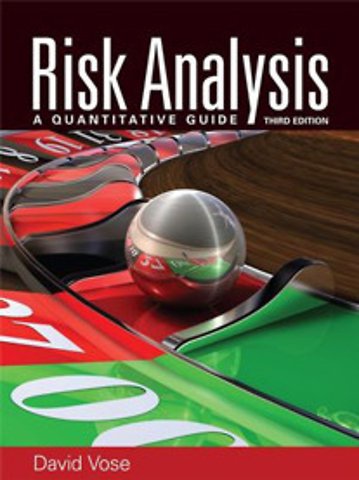Risk Analysis
A quantitative guide, third edition
Gebonden Engels 2008 9780470512845Samenvatting
Risico en onzekerheid spelen een sleutelrol in veel bedrijven en overheidsproblemen en er is veel kennis van zaken in deze nodig om rationele beslissingen te kunnen maken.
Dit boek houdt zich bezig met de kwantificering van risico, het in kaart brengen van geïdentificeerde risico's en hoe men m.b.v. deze modellen beslissingen kan maken.
Specificaties
Lezersrecensies
Inhoudsopgave
Part 1: Introduction
1. Why do a risk analysis?
1.1. Moving on from 'What If' Scenarios
1.2. The Risk Analysis Process
1.3. Risk Management Options
1.4. Evaluating Risk Management Options
1.5. Inefficiencies in Transferring Risks to Others
1.6. Risk Registers
2. Planning a risk analysis
2.1. Questions and Motives
2.2. Determine the Assumptions that are Acceptable or Required
2.3. Time and Timing
2.4. You'll Need a Good Risk Analyst or Team
3. The quality of a risk analysis
3.1. The Reasons Why a Risk Analysis can be Terrible
3.2. Communicating the Quality of Data Used in a Risk Analysis
3.3. Level of Criticality
3.4. The Biggest Uncertainty in a Risk Analysis
3.5. Iterate
4. Choice of model structure
4.1. Software Tools and the Models they Build.
4.2. Calculation Methods.
4.3. Uncertainty and Variability.
4.4. How Monte Carlo Simulation Works
4.5. Simulation Modelling
5. Understanding and using the results of a risk analysis
5.1. Writing a Risk Analysis Report
5.2. Explaining a Model's Assumptions
5.3. Graphical Presentation of a Model's Results
5.4. Statistical Methods of Analysing Results
Part 2: Introduction
6. Probability mathematics and simulation
6.1. Probability Distribution Equations
6.2. The Definition of 'Probability'
6.3. Probability Rules
6.4. Statistical Measures
7. Building and running a model
7.1. Model Design and Scope
7.2. Building Models that are Easy to Check and Modify
7.3. Building Models that are Efficient
7.4. Most Common Modelling Errors
8. Some basic random processes
8.1. Introduction
8.2. The Binomial Process
8.3. The Poisson Process
8.4. The Hypergeometric Process
8.5. Central Limit Theorem
8.6. Renewal Processes
8.7. Mixture Distributions
8.8. Martingales
8.9. Miscellaneous Example
9. Data and statistics
9.1. Classical Statistics
9.2. Bayesian Inference
9.3. The Bootstrap
9.4. Maximum Entropy Principle
9.5. Which Technique Should You Use?
9.6. Adding uncertainty in Simple Linear Least-Squares Regression Analysis
10. Fitting distributions to data
10.1. Analysing the Properties of the Observed Data
10.2. Fitting a Non-Parametric Distribution to the Observed Data
10.3. Fitting a First-Order Parametric Distribution to Observed Data
10.4. Fitting a Second-Order Parametric Distribution to Observed Data
11. Sums of random variables
11.1. The Basic Problem
11.2. Aggregate Distributions
12. Forecasting with uncertainty
12.1. The Properties of a Time Series Forecast
12.2. Common Financial Time Series Models
12.3. Autoregressive Models
12.4. Markov Chain Models
12.5. Birth and Death Models
12.6. Time Series Projection of Events Occurring Randomly in Time
12.7. Time Series Models with Leading Indicators
12.8. Comparing Forecasting Fits for Different Models
12.9. Long-Term Forecasting
13. Modelling correlation and dependencies
13.1. Introduction
13.2. Rank Order Correlation
13.3. Copulas
13.4. The Envelope Method
13.5. Multiple Correlation Using a Look-Up Table
14. Eliciting from expert opinion
14.1. Introduction
14.2. Sources of Error in Subjective Estimation
14.3. Modelling Techniques
14.4. Calibrating Subject Matter Experts
14.5. Conducting a Brainstorming Session
14.6. Conducting the Interview
15. Testing and modelling causal relationships
15.1. Campylobacter Example
15.2. Types of Model to Analyse Data
15.3. From Risk Factors to Causes
15.4. Evaluating Evidence
15.5. The Limits of Causal Arguments
15.6. An Example of a Qualitative Causal Analysis
15.7. Is Causal Analysis Essential?
16. Optimisation in risk analysis
16.1. Introduction
16.2. Optimisation Methods
16.3. Risk Analysis Modelling and Optimisation
16.4. Working Example: Optimal Allocation of Mineral Pots
17. Checking and validating a model
17.1. Spreadsheet Model Errors
17.2. Checking Model Behaviour
17.3. Comparing Predictions Against Reality
18. Discounted cash-flow modelling
18.1. Useful Time Series Models of Sales and Market Size
18.2. Summing Random Variables
18.3. Summing Variable Margins on Variable Revenues
18.4. Financial Measures in Risk Analysis
19. Project risk analysis
19.1. Cost Risk Analysis
19.2. Schedule Risk Analysis
19.3. Portfolios of risks
19.4. Cascading Risks
20. Insurance and finance risk analysis modelling
20.1. Operational Risk Modelling
20.2. Credit Risk
20.3. Credit Ratings and Markov Chain Models
20.4. Other Areas of Financial Risk
20.5. Measures of Risk
20.6. Term Life Insurance
20.7. Accident Insurance
20.8. Modelling a Correlated Insurance Portfolio
20.9. Modelling Extremes
20.10. Premium Calculations
21. Microbial food safety risk assessment
21.1. Growth and Attenuation Models
21.2. Dose-Response Models
21.3. Is Monte Carlo Simulation the Right Approach?
21.4. Some Model Simplifications
22. Animal import risk assessment
22.1. Testing for an Infected Animal
22.2. Estimating True Prevalence in a Population
22.3. Importing Problems
22.4. Confidence of Detecting an Infected Group
22.5. Miscellaneous Animal Health and Food Safety Problems
I. Guide for lecturers
II. About ModelRisk
III. A compendium of distributions
III.1. Discrete and Continuous Distributions
III.2. Bounded and Unbounded Distributions
III.3. Parametric and Non-Parametric Distributions
III.4. Univariate and Multivariate Distributions
III.5. Lists of Applications and the Most Useful Distributions
III.6. How to Read Probability Distribution Equations
III.7. The Distributions
III.8. Introduction to Creating Your Own Distributions
III.9. Approximation of One Distribution with Another
III.10. Recursive Formulae for Discrete Distributions
III.11. A Visual Observation On The Behaviour Of Distributions
IV. Further reading
V. Vose Consulting
References
Index
Anderen die dit boek kochten, kochten ook
Rubrieken
- advisering
- algemeen management
- coaching en trainen
- communicatie en media
- economie
- financieel management
- inkoop en logistiek
- internet en social media
- it-management / ict
- juridisch
- leiderschap
- marketing
- mens en maatschappij
- non-profit
- ondernemen
- organisatiekunde
- personal finance
- personeelsmanagement
- persoonlijke effectiviteit
- projectmanagement
- psychologie
- reclame en verkoop
- strategisch management
- verandermanagement
- werk en loopbaan






